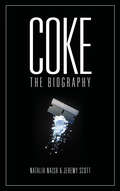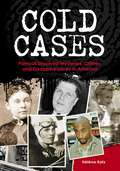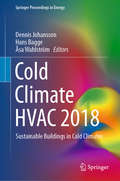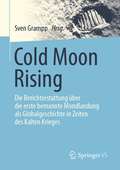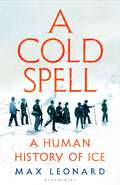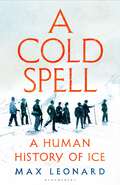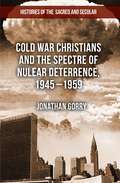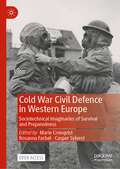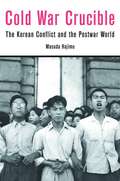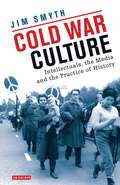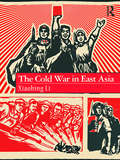- Table View
- List View
Coke: The Biography
by Jeremy ScottThat airy disclaimer, uttered by Tallulah Bankhead, has long been an article of faith for coke's legion of fans - and little has changed since cocaine's sensational debut in the Belle Epoque. Alternately glorified and demonised, hailed as a miraculous cure-all or blamed for society's failings, the White Lady has gone global. Today, she is the stimulant of choice for European partiers and stressed-out bankers alike - and everyone from producer to consumer is playing a high-stakes game. In Coke, Natalia Naish and Jeremy Scott recount the sweeping history of cocaine since its first appearance, charting the highs and lows from pre-history to the present day. With personality led stories of its more notorious users, including Sigmund Freud, Stevie Nicks, Kate Moss and Amy Winehouse, the tale is rich in anecdote, often tragic and sometimes hilarious. Neither moralistic nor condoning, Coke: The Biography is a thrilling popular history of a global phenomenon.
Cold Case Files Missing and Unsolved: The Cold Case Files
by Barry CumminsThe Cold Case Files will leave you shocked that so many of Ireland’s evil killers have not been caught. But by outlining the on-going work of Ireland’s cold-case detectives, this book will also give you hope that these killers will never be allowed to rest easy, and that one day justice will come knocking on their door.Unsolved: the 1981 fatal shooting of Lorcan O’Byrne, who was targeted by robbers on the night he was celebrating his engagement. Unsolved: the murder of Grace Livingstone, who was found shot dead in her Malahide home in 1992.Unsolved: the abduction and suspected murder of Brooke Pickard, who was last seen in Co. Kerry in 1991.Cummins also charts the re-investigation into the first case to be solved by the Cold Case Unit: the killing and secret burial of Brian McGrath in Westmeath in 1987.
Cold Cases: Famous Unsolved Mysteries, Crimes, and Disappearances in America
by Hélèna KatzThis book explicitly chronicles 40 cases of unsolved murders and disappearances over a period of more than 160 years, tracing the evolution of criminal investigation and forensic techniques.Murders and other violent crimes often leave an indelible mark on society. The 18th-century murder of "Beautiful Cigar Girl" Mary Rogers helped the then newly emerging tabloid papers become a fixture in the United States. The Federal Aviation Administration was spurred into requiring electronic screening of passengers and carry-on luggage by a series of highly-publicized hijackings. Abductions of youth gave birth to Amber Alerts and advertising missing children on milk cartons. And popular TV shows like Law and Order, CSI, and Cold Case document our fascination with police investigations, heinous criminals, and the complicated aftermath of their actions. This book examines 40 well-known cases of unsolved murders and suspected abductions over a period of over 160 years. Cases are organized chronologically to give readers insight into the evolution of criminal investigation techniques and forensics in the last century and a half. Later chapters detail how modern forensics were used in attempts to solve old cold cases or helped generate new leads.
Cold Cases: Famous Unsolved Mysteries, Crimes, and Disappearances in America
by Hélèna KatzThis book explicitly chronicles 40 cases of unsolved murders and disappearances over a period of more than 160 years, tracing the evolution of criminal investigation and forensic techniques.Murders and other violent crimes often leave an indelible mark on society. The 18th-century murder of "Beautiful Cigar Girl" Mary Rogers helped the then newly emerging tabloid papers become a fixture in the United States. The Federal Aviation Administration was spurred into requiring electronic screening of passengers and carry-on luggage by a series of highly-publicized hijackings. Abductions of youth gave birth to Amber Alerts and advertising missing children on milk cartons. And popular TV shows like Law and Order, CSI, and Cold Case document our fascination with police investigations, heinous criminals, and the complicated aftermath of their actions. This book examines 40 well-known cases of unsolved murders and suspected abductions over a period of over 160 years. Cases are organized chronologically to give readers insight into the evolution of criminal investigation techniques and forensics in the last century and a half. Later chapters detail how modern forensics were used in attempts to solve old cold cases or helped generate new leads.
Cold Climate HVAC 2018: Sustainable Buildings In Cold Climates (Springer Proceedings in Energy)
by Dennis Johansson Hans Bagge Åsa WahlströmThis volume presents the proceedings of the 9th Cold Climate HVAC conference, which was held in Kiruna, Sweden in 2018. The conference highlighted key technologies and processes that allow scientists, designers, engineers, manufacturers and other decision makers in cold climate regions to achieve good indoor environmental quality (IEQ) with a minimum use of energy and other resources. The conference addressed various technical, economic and social aspects of buildings and HVAC systems in new and renovated buildings. This proceedings volume gathers peer-reviewed papers by a diverse and international range of authors and showcases perspectives and practices in cold climate building design from around the globe. The following major aspects, which include both fundamental and theoretical research as well as applications and case studies, are covered: (1) Energy and power efficiency and low-energy buildings; (2) Renovating buildings; (3) Efficient HVAC components; (4) Heat pumps and geothermal systems; (5) Municipal and city energy systems; (6) Construction management; (7) Buildings in operation; (8) Building simulation; (9) Reference data; (10) Transdisciplinary connections and social aspects; (11) Indoor environments and health; (12) Moisture safety and water damage; (13) Codes, regulations, standards and policies; and (14) Other aspects of buildings in cold climates.
The Cold Counsel: The Women in Old Norse Literature and Myth
by Sarah M. Anderson Karen SwensonCold Counsel is the only collection devoted to the place of women in Old Norse literature and culture. It draws upon the disciplines of history, sociology, feminism, ethnography and psychoanalysis in order to raise fresh questions about such new subjects as gender, class, sexuality, family structure and ideology in medieval Iceland.
The Cold Counsel: The Women in Old Norse Literature and Myth
by Sarah M. Anderson Karen SwensonCold Counsel is the only collection devoted to the place of women in Old Norse literature and culture. It draws upon the disciplines of history, sociology, feminism, ethnography and psychoanalysis in order to raise fresh questions about such new subjects as gender, class, sexuality, family structure and ideology in medieval Iceland.
Cold, hard steel: The myth of the modern surgeon (Social Histories of Medicine #46)
by Agnes Arnold-ForsterBrilliant, volatile and invariably male, the surgeon stereotype is a widespread and instantly recognisable part of western culture. Setting out to anatomise this stereotype, Cold, hard steel offers an exciting new history of modern and contemporary British surgery. The book draws on archival materials and original interviews with surgeons, analysing them alongside a range of fictional depictions, from the Doctor in the House novels to Mills & Boon romances and the pioneering soap opera Emergency Ward 10. Presenting a unique social, cultural and emotional history, it sheds light on the development and maintenance of the surgical stereotype and explains why it has proved so enduring. At the same time, the book explores the more candid and compassionate image of the surgeon that has begun to emerge in recent years, revealing how a series of high-profile memoirs both challenge the surgical stereotype and simultaneously confirm it.
Cold, hard steel: The myth of the modern surgeon (Social Histories of Medicine #46)
by Agnes Arnold-ForsterBrilliant, volatile and invariably male, the surgeon stereotype is a widespread and instantly recognisable part of western culture. Setting out to anatomise this stereotype, Cold, hard steel offers an exciting new history of modern and contemporary British surgery. The book draws on archival materials and original interviews with surgeons, analysing them alongside a range of fictional depictions, from the Doctor in the House novels to Mills & Boon romances and the pioneering soap opera Emergency Ward 10. Presenting a unique social, cultural and emotional history, it sheds light on the development and maintenance of the surgical stereotype and explains why it has proved so enduring. At the same time, the book explores the more candid and compassionate image of the surgeon that has begun to emerge in recent years, revealing how a series of high-profile memoirs both challenge the surgical stereotype and simultaneously confirm it.
Cold Moon Rising: Die Berichterstattung über die erste bemannte Mondlandung als Globalgeschichte in Zeiten des Kalten Krieges
by Sven GramppIn diesem Sammelband wird eine Welt- und Zeitreise in 21 Ländern auf nicht weniger als sechs Kontinente unternommen. So soll die globale Rezeption eines der bis dato größten Medienereignisse Kontur erhalten. Anhand der Berichterstattung über die erste bemannte Mondlandung kann so die Globalgeschichte im/des Kalten Krieges zu Zeiten des Space Racesowohl in ihren vielen unterschiedlichen lokalen Facetten als auch in ihrer weltweiten Vernetzung erzählt werden.Vor dem Hintergrund gegenwärtiger Bestrebungen diverser Länder, wieder auf den Mond zurückzukehren oder gleich eine Weltraumarmee zu gründen, wie auch in Anbetracht der überaus angespannten geopolitischen Lage, die bereits vielerorts als ‚Kalter Krieg 2.0‘ beschworen wird, scheint solch ein weltumspannender Blick zurück in die Zeit des ‚Kalten Krieges 1.0‘ durchaus von Relevanz, um Gegenwart und nahe Zukunft politischer (Medien-)Kulturen besser zu verstehen.
A Cold Spell: A Human History of Ice
by Max LeonardTaking us from the beginning of our story to the present day, A Cold Spell examines how ice has shaped our thoughts, actions and societies – and what it means for us that it is rapidly disappearing from our planet'Bracingly original . . . As the earth warms threateningly, there could hardly be a more pertinent time for a story like this' MICHAEL PALIN'A book of limitless fascinations' OLIVIA LAING'A thought-provoking chronicle of humanity . . . Leonard consistently frames ice in surprising and insightful ways, and in doing so lends it a magical quality' GEOGRAPHICALIce has confounded, delighted and fascinated us since the first sparks of art and culture in Europe and it now underpins the modern world. Without ice, we would not feed ourselves or heal our sick as we do, and our towns and cities, countryside and oceans would look very different. Science would not have progressed along the avenues it did and our galleries and libraries would be missing many masterpieces.A Cold Spell uses this vital link to understanding our past to tell a surprising story of obsession, invention and adventure – how we have lived and dreamed, celebrated and traded, innovated, loved and fought over thousands of years. It brings together a sacrificial Incan mummy, Winston Churchill's secret plans for unusual aircraft carriers, strange bones that shook Victorian beliefs about the world and a macabre journey into the depths of the human body. It is an original and unique way of looking at something that is literally all around us, whose loss confronts us daily in the news, but whose impact on our lives has never been fully explored.
A Cold Spell: A Human History of Ice
by Max LeonardTaking us from the beginning of our story to the present day, A Cold Spell examines how ice has shaped our thoughts, actions and societies – and what it means for us that it is rapidly disappearing from our planet'Bracingly original . . . As the earth warms threateningly, there could hardly be a more pertinent time for a story like this' MICHAEL PALIN'A book of limitless fascinations' OLIVIA LAING'Brightly written, nimbly researched and really quite delightful' LITERARY REVIEW'A thought-provoking chronicle of humanity . . . Leonard consistently frames ice in surprising and insightful ways, and in doing so lends it a magical quality' GEOGRAPHICALIce has confounded, delighted and fascinated us since the first sparks of art and culture in Europe and it now underpins the modern world. Without ice, we would not feed ourselves or heal our sick as we do, and our towns and cities, countryside and oceans would look very different. Science would not have progressed along the avenues it did and our galleries and libraries would be missing many masterpieces.A Cold Spell uses this vital link to understanding our past to tell a surprising story of obsession, invention and adventure – how we have lived and dreamed, celebrated and traded, innovated, loved and fought over thousands of years. It brings together a sacrificial Incan mummy, Winston Churchill's secret plans for unusual aircraft carriers, strange bones that shook Victorian beliefs about the world and a macabre journey into the depths of the human body. It is an original and unique way of looking at something that is literally all around us, whose loss confronts us daily in the news, but whose impact on our lives has never been fully explored.
The Cold War and the Color Line: American Race Relations in the Global Arena
by Thomas BorstelmannAfter World War II the United States faced two preeminent challenges: how to administer its responsibilities abroad as the world's strongest power, and how to manage the rising movement at home for racial justice and civil rights. The effort to contain the growing influence of the Soviet Union resulted in the Cold War, a conflict that emphasized the American commitment to freedom. The absence of that freedom for nonwhite American citizens confronted the nation's leaders with an embarrassing contradiction. Racial discrimination after 1945 was a foreign as well as a domestic problem. World War II opened the door to both the U.S. civil rights movement and the struggle of Asians and Africans abroad for independence from colonial rule. America's closest allies against the Soviet Union, however, were colonial powers whose interests had to be balanced against those of the emerging independent Third World in a multiracial, anticommunist alliance. At the same time, U.S. racial reform was essential to preserve the domestic consensus needed to sustain the Cold War struggle. The Cold War and the Color Line is the first comprehensive examination of how the Cold War intersected with the final destruction of global white supremacy. Thomas Borstelmann pays close attention to the two Souths--Southern Africa and the American South--as the primary sites of white authority's last stand. He reveals America's efforts to contain the racial polarization that threatened to unravel the anticommunist western alliance. In so doing, he recasts the history of American race relations in its true international context, one that is meaningful and relevant for our own era of globalization.
Cold War Christians and the Spectre of Nuclear Deterrence, 1945-1959 (Histories of the Sacred and Secular, 1700–2000)
by J. GorryOffering a new interpretation of early Cold War history, this book demonstrates how Christian agency played a pivotal role in the creating of space for the logic of nuclear deterrence and nuclear war, showing a balanced examination of Christians as enablers but, more provocatively, as resisters of nuclear prohibitions.
Cold War Cities: The Politics of Space in Europe and Asia during the 1950s (Routledge Studies in the Modern History of Asia)
by Tze-Ki HonThis book is a dynamic study of the range of experiences of the Cold War in Europe, East Asia and Southeast Asia in the 20th century. Comprised of ten chapters from a diverse team of scholars from Europe, East Asia, and North America, this edited volume furthers the study of the Cold War in two ways. First, it underscores the global scope of the Cold War. Beginning from Europe and extending to East and Southeast Asia, it focuses attention on the overlapping local, national, regional, and international rivalries that ultimately divided the world into two opposing camps. Second, it shows that the Cold War had different impacts in different places. Although not all continents are included, this volume demonstrates that the bipolar system was not monolithic and uniform. By comparing experiences in various cities, this book critically examines the ways in which the bipolar system was circumvented or transformed – particularly in places where the line between the Free World and the Communist World was unclear. Cold War Cities will appeal to students and scholars of history and Cold War studies, cultural geography and material cultures, as well as East and Southeast Asian studies.
Cold War Cities: The Politics of Space in Europe and Asia during the 1950s (Routledge Studies in the Modern History of Asia)
by Tze-Ki HonThis book is a dynamic study of the range of experiences of the Cold War in Europe, East Asia and Southeast Asia in the 20th century. Comprised of ten chapters from a diverse team of scholars from Europe, East Asia, and North America, this edited volume furthers the study of the Cold War in two ways. First, it underscores the global scope of the Cold War. Beginning from Europe and extending to East and Southeast Asia, it focuses attention on the overlapping local, national, regional, and international rivalries that ultimately divided the world into two opposing camps. Second, it shows that the Cold War had different impacts in different places. Although not all continents are included, this volume demonstrates that the bipolar system was not monolithic and uniform. By comparing experiences in various cities, this book critically examines the ways in which the bipolar system was circumvented or transformed – particularly in places where the line between the Free World and the Communist World was unclear. Cold War Cities will appeal to students and scholars of history and Cold War studies, cultural geography and material cultures, as well as East and Southeast Asian studies.
Cold War Civil Defence in Western Europe: Sociotechnical Imaginaries of Survival and Preparedness
by Casper Sylvest Marie Cronqvist Rosanna FarbølThis open access edited collection brings together established and new perspectives on Cold War civil defence in Western Europe within a common analytical framework that also facilitates comparative and transnational dimensions. The current interest in creating disaster-resilient societies demands new histories of civil defence. Historical contextualization is essential in order to understand what is at stake in preparing, devising, and implementing forms of preparedness, protection, and security that are specifically targeted at societies and citizens. Applying the concept of sociotechnical imaginaries to civil defence history, the chapters of this volume cover a range of new themes, from technology and materiality to media, memory, and everyday experience. The book underlines the social embeddedness of civil defence by detailing how it both prompted new forms of social interaction and reflected norms and visions of the ‘good society’ in an age where nuclear technology seemed to hold the key to both doom and salvation.
Cold War Crucible: The Korean Conflict and the Postwar World
by Masuda HajimuAfter World War II, the major powers faced social upheaval at home and anti-colonial wars around the globe. Alarmed by conflict in Korea that could change U.S.-Soviet relations from chilly to nuclear, ordinary people and policymakers created a fantasy of a bipolar Cold War world in which global and domestic order was paramount, Masuda Hajimu shows.
Cold War Crucible: The Korean Conflict and the Postwar World
by Masuda HajimuAfter World War II, the major powers faced social upheaval at home and anti-colonial wars around the globe. Alarmed by conflict in Korea that could change U.S.-Soviet relations from chilly to nuclear, ordinary people and policymakers created a fantasy of a bipolar Cold War world in which global and domestic order was paramount, Masuda Hajimu shows.
Cold War Culture: Intellectuals, the Media and the Practice of History (International Library of Twentieth Century History)
by Jim SmythBritain in the 1950s had a distinctive political and intellectual climate. It was the age of Keynesianism, of welfare state consensus, incipient consumerism, and, to its detractors - the so-called 'Angry Young Men' and the emergent New Left - a new age of complacency. While Prime Minister Harold Macmillan famously remarked that 'most of our people have never had it so good', the playwright John Osborne lamented that 'there aren't any good, brave causes left'.Philosophers, political scientists, economists and historians embraced the supposed 'end of ideology' and fetishized 'value-free' technique and analysis. This turn is best understood in the context of the cultural Cold War in which 'ideology' served as shorthand for Marxist, but it also drew on the rich resources and traditions of English empiricism and a Burkean scepticism about abstract theory in general. Ironically, cultural critics and historians such as Raymond Williams and E.P. Thompson showed at this time that the thick catalogue of English moral, aesthetic and social critique could also be put to altogether different purposes. Jim Smyth here shows that, despite being allergic to McCarthy-style vulgarity, British intellectuals in the 1950s operated within powerful Cold War paradigms all the same.
Cold War Cultures: Perspectives on Eastern and Western European Societies
by Annette Vowinckel, Marcus M. Payk Thomas LindenbergerThe Cold War was not only about the imperial ambitions of the super powers, their military strategies, and antagonistic ideologies. It was also about conflicting worldviews and their correlates in the daily life of the societies involved. The term “Cold War Culture” is often used in a broad sense to describe media influences, social practices, and symbolic representations as they shape, and are shaped by, international relations. Yet, it remains in question whether — or to what extent — the Cold War Culture model can be applied to European societies, both in the East and the West. While every European country had to adapt to the constraints imposed by the Cold War, individual development was affected by specific conditions as detailed in these chapters. This volume offers an important contribution to the international debate on this issue of the Cold War impact on everyday life by providing a better understanding of its history and legacy in Eastern and Western Europe.
The Cold War in East Asia
by Xiaobing LiThis textbook provides a survey of East Asia during the Cold War from 1945 to 1991. Focusing on the persistence and flexibility of its culture and tradition when confronted by the West and the US, this book investigates how they intermesh to establish the nations that have entered the modern world. Through the use of newly declassified Communist sources, the narrative helps students form a better understanding of the origins and development of post-WWII East Asia. The analysis demonstrates how East Asia’s position in the Cold War was not peripheral but, in many key senses, central. The active role that East Asia played, ultimately, turned this main Cold War battlefield into a "buffer" between the United States and the Soviet Union. Covering a range of countries, this textbook explores numerous events, which took place in East Asia during the Cold War, including: The occupation of Japan, Civil war in China and the establishment of Taiwan, The Korean War, The Vietnam War, China’s Reforming Movement. Moving away from Euro-American centric approaches and illuminating the larger themes and patterns in the development of East Asian modernity, The Cold War in East Asia is an essential resource for students of Asian History, the Cold War and World History.
The Cold War in the Classroom: International Perspectives on Textbooks and Memory Practices (Palgrave Studies in Educational Media)
by Barbara Christophe Peter Gautschi Robert ThorpThis book is open access under a CC BY 4.0 license.This book explores how the socially disputed period of the Cold War is remembered in today’s history classroom. Applying a diverse set of methodological strategies, the authors map the dividing lines in and between memory cultures across the globe, paying special attention to the impact the crisis-driven age of our present has on images of the past. Authors analysing educational media point to ambivalence, vagueness and contradictions in textbook narratives understood to be echoes of societal and academic controversies. Others focus on teachers and the history classroom, showing how unresolved political issues create tensions in history education. They render visible how teachers struggle to handle these challenges by pretending that what they do is ‘just history’. The contributions to this book unveil how teachers, backgrounding the political inherent in all memory practices, often nourish the illusion that the history in which they are engaged is all about addressing the past with a reflexive and disciplined approach.
Cold War in the High Himalayas: The USA, China and South Asia in the 1950s
by S Mahmud Ali S. Mahmud AliThis text examines elite-insecurity perceptions in India, Pakistan and the USA in the 1950s. The book highlights the consequent linkages in alliance-building efforts and the subsequent triangular covert collaboration against Communist China, especially along Tibet's Himalayan frontiers. This secret alliance had an unexpected fall-out on the Kashmir dispute between India and Pakistan. Lastly the book examines the divergence of Indo-Pakistani security policies along fundamental cleavages since the 1960s.
Cold War in the High Himalayas: The USA, China and South Asia in the 1950s
by S Mahmud Ali S. Mahmud AliThis text examines elite-insecurity perceptions in India, Pakistan and the USA in the 1950s. The book highlights the consequent linkages in alliance-building efforts and the subsequent triangular covert collaboration against Communist China, especially along Tibet's Himalayan frontiers. This secret alliance had an unexpected fall-out on the Kashmir dispute between India and Pakistan. Lastly the book examines the divergence of Indo-Pakistani security policies along fundamental cleavages since the 1960s.
